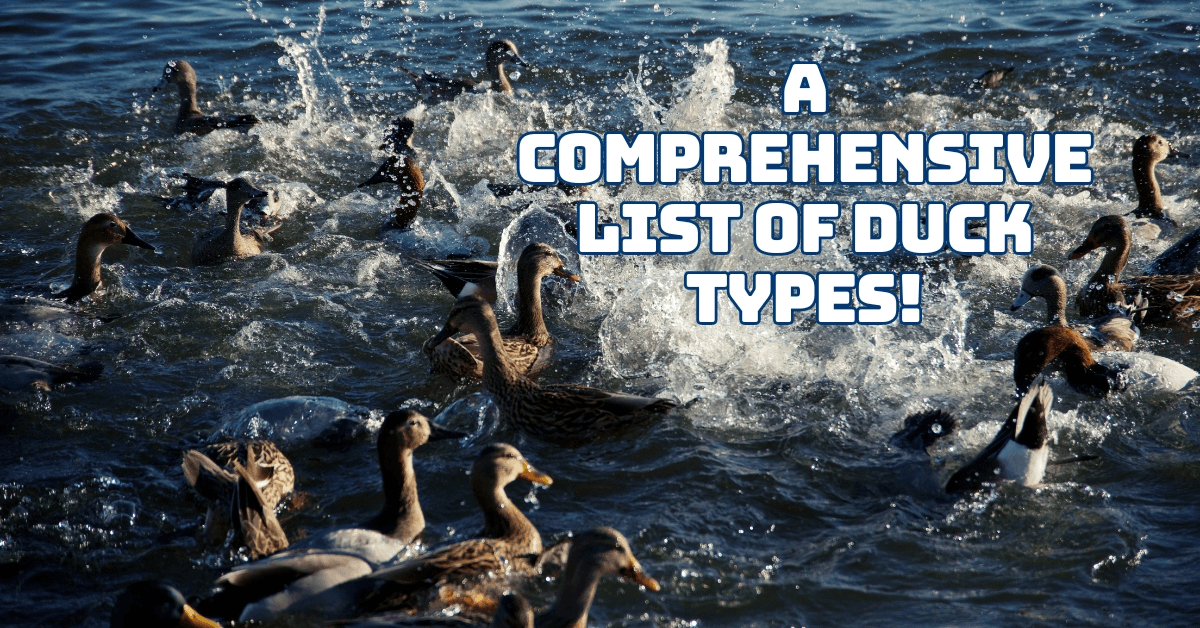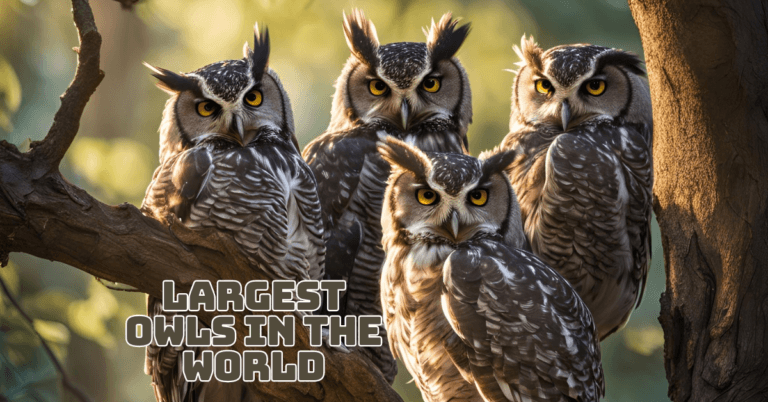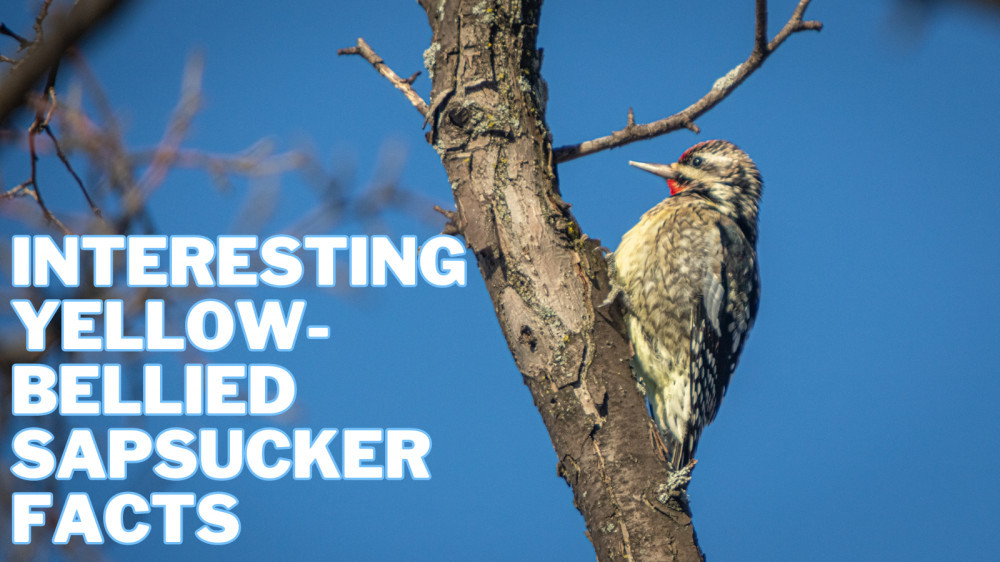A Comprehensive List Of Duck Types
A Comprehensive List Of Duck Types
Have you ever wondered what makes ducks uniquely captivating in the avian world?
Ducks are among the most diverse and fascinating birds, captivating birdwatchers and nature enthusiasts with their vibrant colours, unique behaviours, and varied habitats.
Whether dabbling in freshwater ponds, diving in coastal bays, or perching in wooded swamps, each duck species has distinct characteristics that set it apart.
From the iconic Mallard to the exotic Spectacled Eider, this comprehensive list of duck types will take you through the remarkable diversity of these waterfowl.
Learn about ducks' physical features, habitats, diets, and behaviours and discover why they play a crucial role in our ecosystems. Dive into the world of ducks and explore the unique traits that make each species special.
List Of Duck Types
Ducks are diverse waterfowl with varying features, habits, and habitats. Here's a list of 25 different duck types.

1. Mallard (Anas platyrhynchos)
The Mallard is one of the most recognizable and widespread duck species. Males (drakes) have a glossy green head, white neck ring, and chestnut-brown chest, while females (hens) are mottled brown with an orange bill.
They inhabit many wetland habitats, including ponds, lakes, rivers, marshes, and coastal estuaries. They are highly adaptable and can also be found in urban parks.
Mallards are omnivorous, feeding on various aquatic plants, insects, small fish, and grains. They often forage by dabbling on the water's surface or grazing on land.
Mallards are the progenitors of most domestic duck breeds. They are known for their adaptability and ability to thrive in diverse environments.
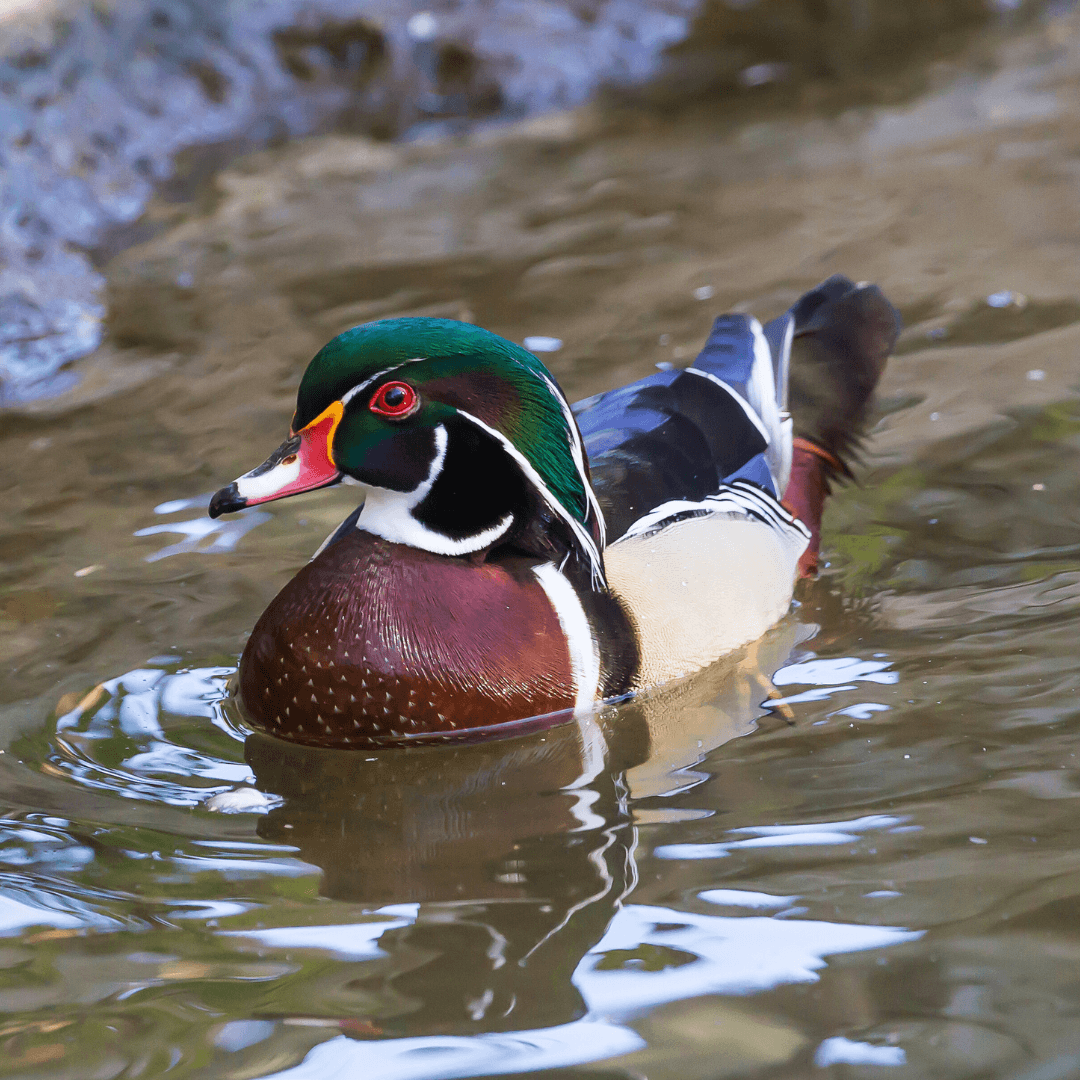
2. Wood Duck (Aix sponsa)
The Wood Duck is one of the most colourful ducks in North America. Males have iridescent green and purple head plumage, red eyes, and a distinctive white throat patch, while females are more subdued, with a gray-brown body and white eye ring.
Wood Ducks prefer wooded swamps, marshes, and streams with abundant tree cover and often nest in tree cavities near water.
They feed on various foods, including acorns, seeds, fruits, insects, and small aquatic animals. They are excellent divers and foragers.
Wood Ducks are known for their ability to perch on branches and nest in trees, thanks to their strong claws.
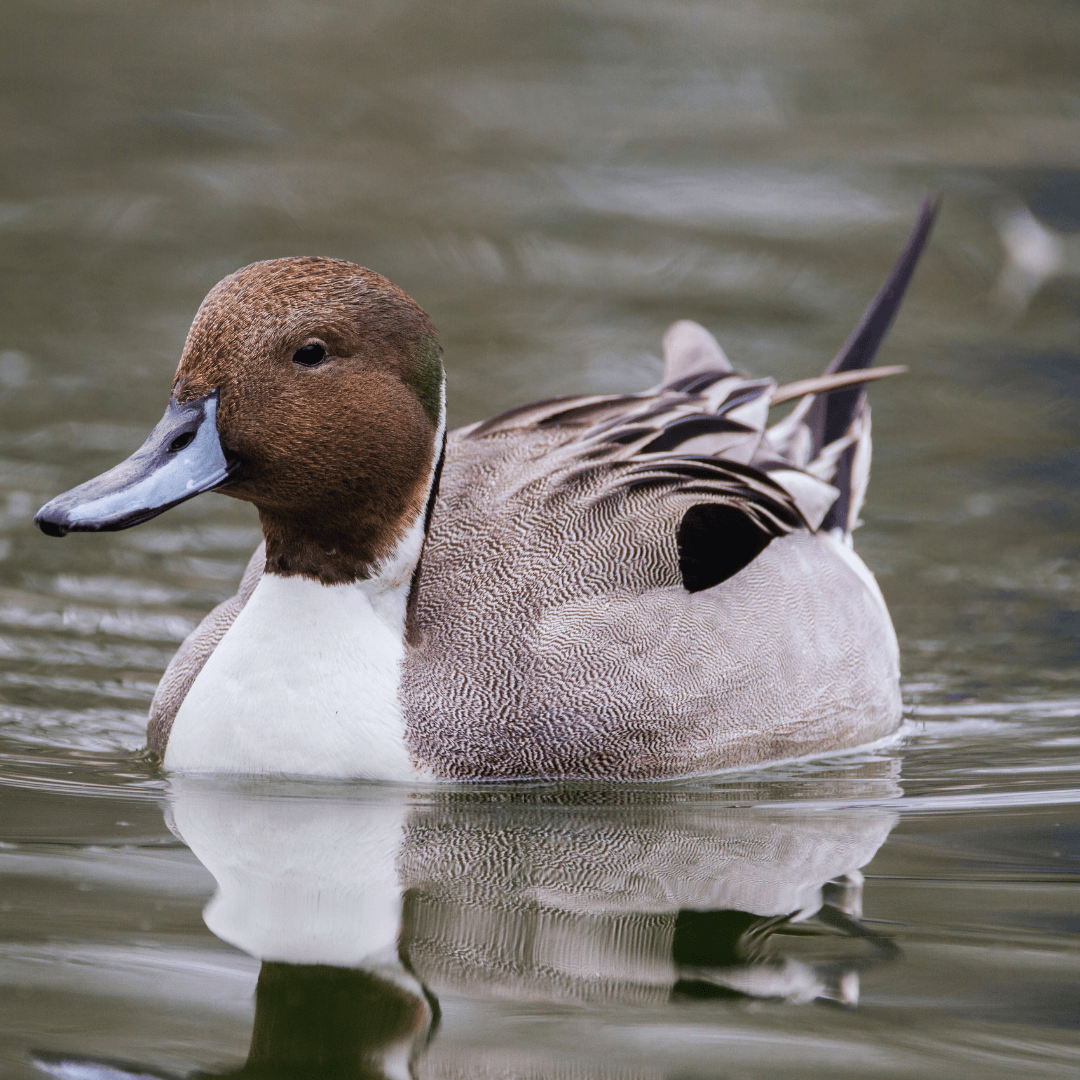
3. Northern Pintail (Anas acuta)
The Northern Pintail is an elegant duck with a slender neck and long, pointed tail feathers. Males have a chocolate-brown head, white neck, and gray body, while females are mottled brown.
Pintails favour shallow wetlands, including marshes, prairie potholes, and estuaries, and are often found in open, grassy areas during the breeding season.
They are omnivorous, feeding on seeds, aquatic plants, insects, and crustaceans by dabbling and upending in shallow water.
Pintails are prized for their agility and speed in flight. They are also known for their graceful flight and distinctive tail feathers, which make them easily identifiable in the field.
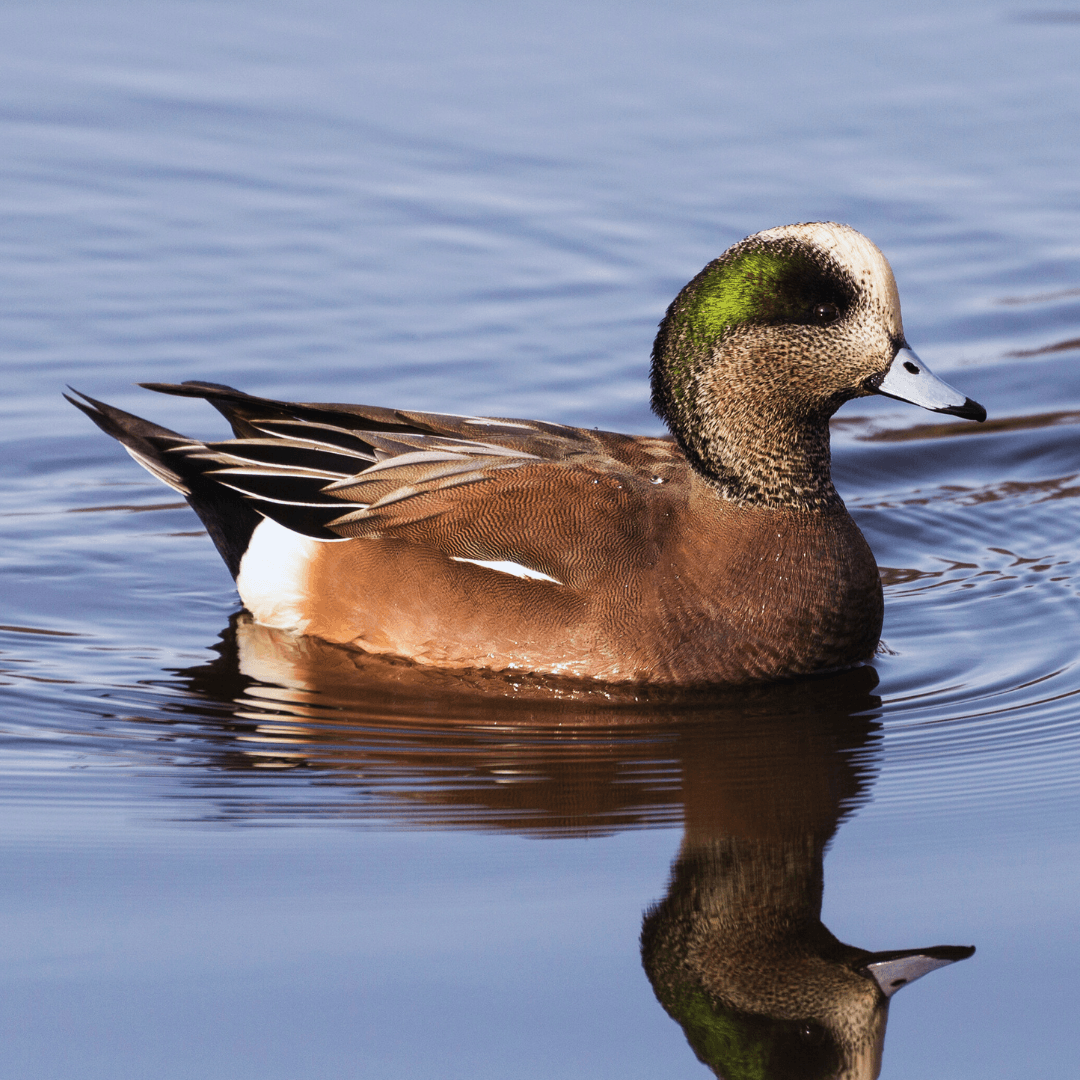
4. American Wigeon (Mareca americana)
American Wigeons are medium-sized ducks with steep foreheads and short bills. Males have a white forehead, green eye patch, and pinkish-brown body, while females are mottled brown with a gray head.
They inhabit freshwater wetlands, including lakes, ponds, and marshes, preferring areas with abundant aquatic vegetation.
Wigeons feed on aquatic plants and grasses and consume insects and crustaceans. They often graze on land alongside geese.
American Wigeons have a unique whistling call that distinguishes them from other ducks. They are also known for stealing food from diving ducks, showcasing their opportunistic feeding behaviour.

5. Gadwall (Mareca strepera)
Gadwalls are medium-sized ducks with relatively plain plumage. Males have a gray-brown body with a white belly and black rump, while females are mottled brown.
They prefer freshwater wetlands, including marshes, lakes, and ponds, often in areas with dense aquatic vegetation.
Gadwalls feed on aquatic plants, algae, small invertebrates, and seeds. They forage by dabbling and grazing.
Gadwalls are known for their quiet demeanour and subtle plumage, making them less conspicuous than other duck species.
They are skilled at avoiding predators by staying close to dense vegetation and blending into their surroundings effectively.
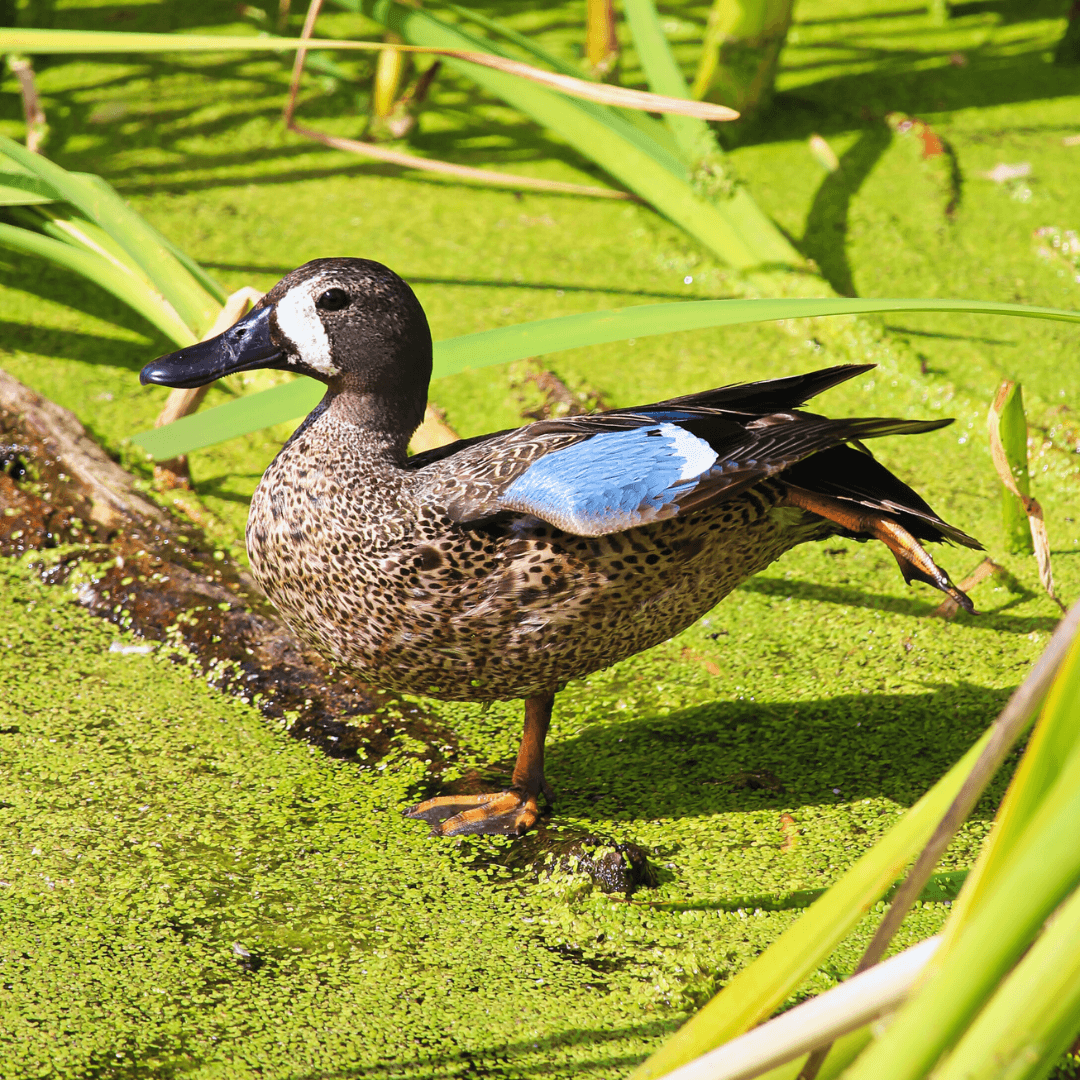
6. Blue-winged Teal (Spatula discors)
Blue-winged Teals are small ducks with a distinctive blue patch on their wings. Males have gray heads, white facial crescents, and brown bodies, while females are mottled brown.
They prefer shallow freshwater wetlands, including marshes, ponds, and flooded fields with dense vegetation.
Blue-winged Teals feed on various foods, including seeds, aquatic plants, insects, and crustaceans. They forage by dabbling and skimming the water's surface.
Known for their long migratory journeys, Blue-winged Teals travel from North America to Central and South America for the winter, showcasing their remarkable endurance and adaptability to different environments.

7. Canvasback (Aythya valisineria)
Canvasbacks are large diving ducks with distinctive profiles. Males have redheads, black chests, and white bodies, while females are mottled brown with pale heads.
They inhabit large freshwater lakes, marshes, and coastal bays with abundant submerged vegetation.
Canvasbacks feed on aquatic plants, particularly wild celery, but consume invertebrates and small fish. They are proficient divers and foragers.
Known for their speed and agility in flight, Canvasbacks have a unique wedge-shaped head and long, sloping profile. Hunters highly prize them for their challenging hunts and excellent table fare.
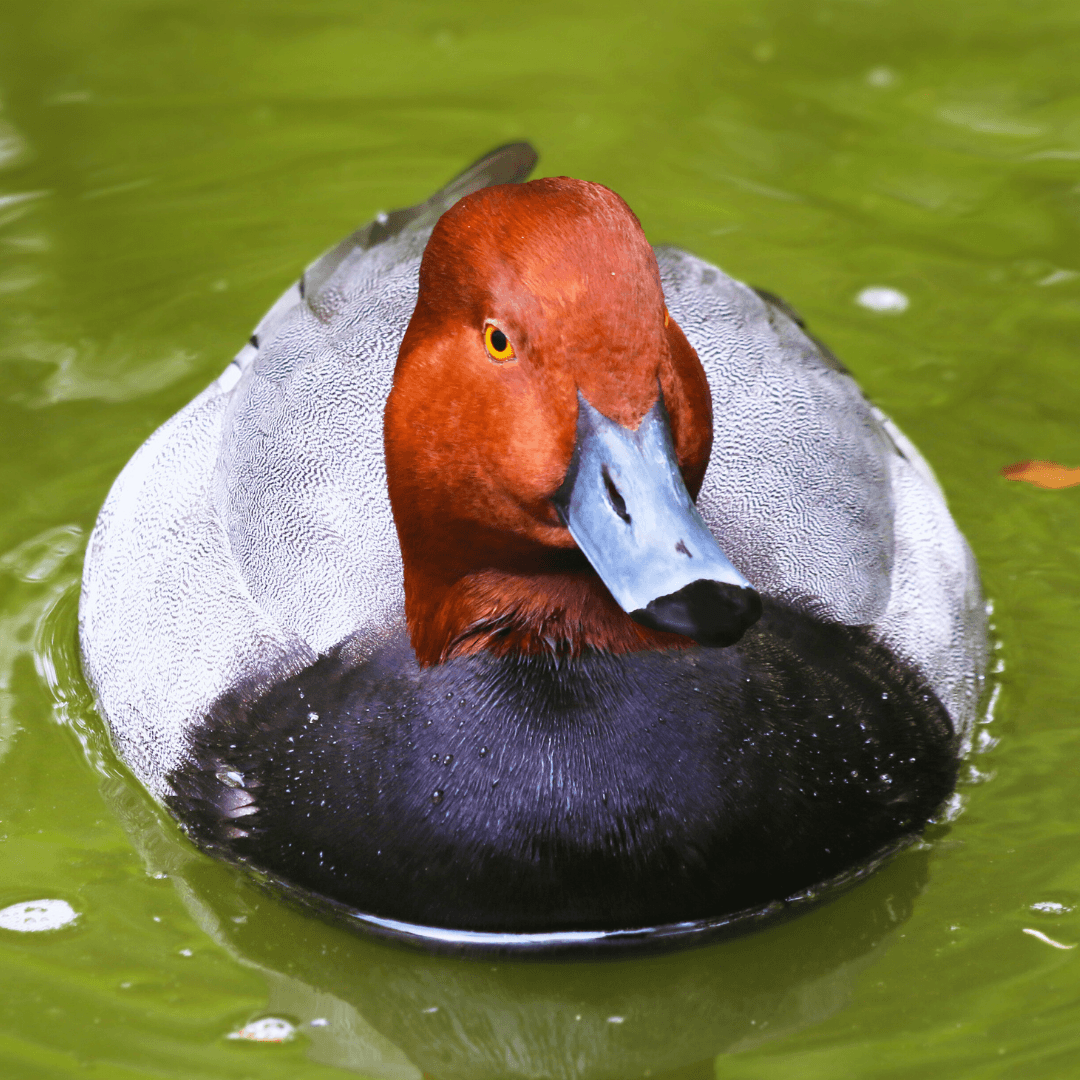
8. Redhead (Aythya americana)
Redheads are medium-sized diving ducks. Males have reddish-brown heads, black chests, and gray bodies, while females are mottled brown with pale faces.
They prefer freshwater lakes, marshes, and coastal bays, often nesting in dense vegetation near water.
Redheads feed on various aquatic plants, seeds, and invertebrates by diving and foraging underwater.
Redheads are recognized for their eye-catching redheads and unique feathers, and they are frequently seen in combined groups with other diving ducks.
Their distinctive appearance and feeding habits make them popular among bird watchers and hunters.

9. Common Eider (Somateria mollissima)
Common Eiders are large sea ducks with bulky builds. Males have striking black-and-white plumage with green napes, while females are mottled brown.
They inhabit coastal marine environments, including rocky shores, islands, and estuaries, often in cold northern waters.
Eiders primarily feed on mollusks, crustaceans, and small fish by diving in deep water. They are known for insulating down feathers and are harvested for high-quality down products. Common Eiders have a unique, deep call.
Their robust builds and ability to thrive in harsh, cold environments make them fascinating subjects for study and admiration.
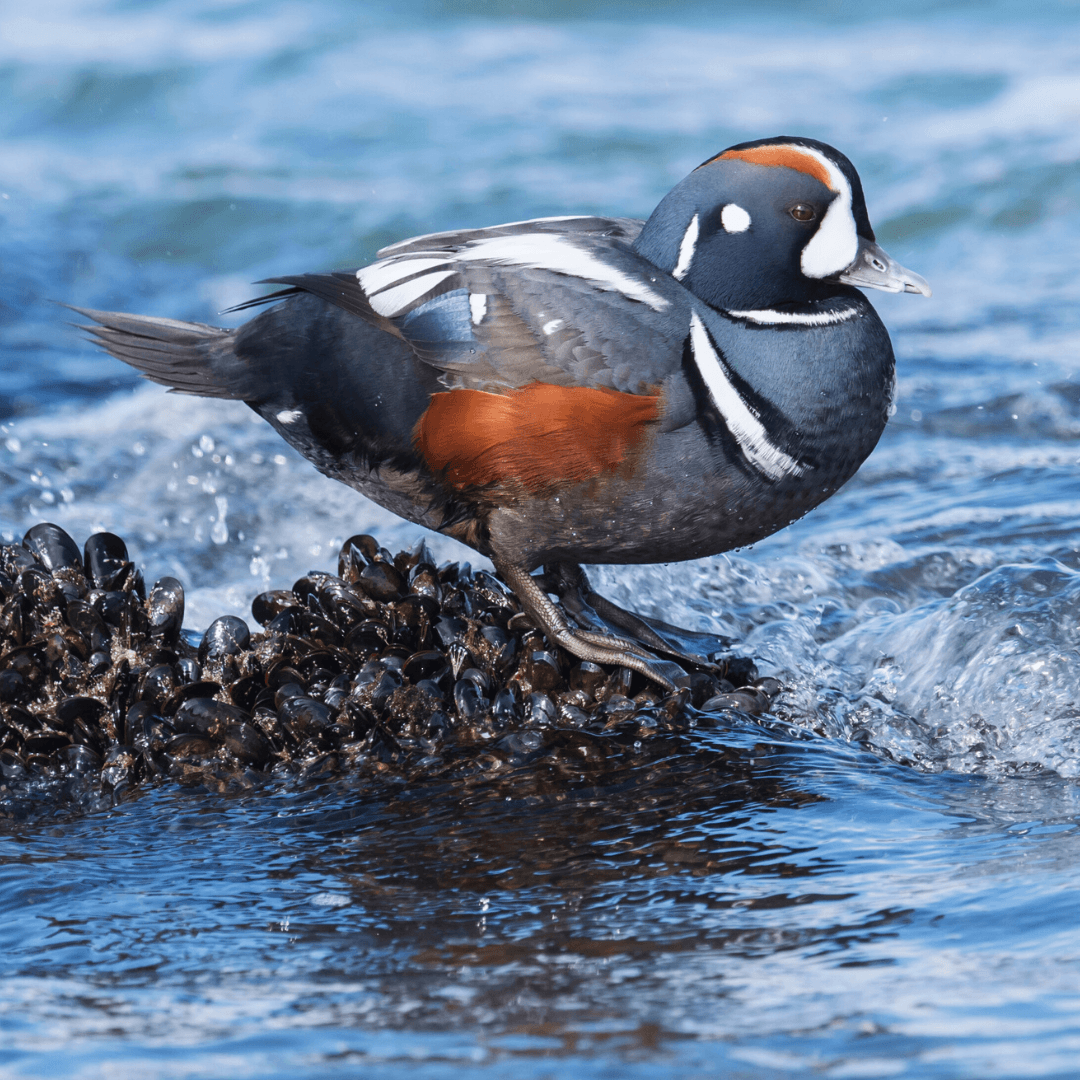
10. Harlequin Duck (Histrionicus histrionicus)
Harlequin Ducks are small sea ducks with striking plumage. Males have slate-blue bodies with white stripes and chestnut sides, while females are dark brown with white facial spots.
They prefer fast-moving streams and rocky coastlines, often in turbulent waters and mountainous regions.
By diving in fast-flowing water, Harlequin Ducks feed on aquatic invertebrates, including insects, crustaceans, and mollusks.
Named after the colourful harlequin costume, these ducks are known for their striking appearance and unique habitat preferences. Their ability to thrive in fast-moving water makes them unique among duck species.

11. Ruddy Duck (Oxyura jamaicensis)
Ruddy Ducks are small, stout diving ducks. Males feature bright chestnut bodies, bluebills, and stiff, upright tails, while females are brown with pale cheeks and darker caps.
Ruddy ducks inhabit densely vegetated freshwater marshes, ponds, and lakes. They feed on seeds, aquatic plants, insects, and crustaceans by diving and foraging underwater.
Known for their courtship displays, where males perform head-throwing and bubbling behaviours, Ruddy Ducks are distinctive with their stiff tails and vibrant plumage.
Their unique mating behaviours and striking appearance make them a favourite among birdwatchers.
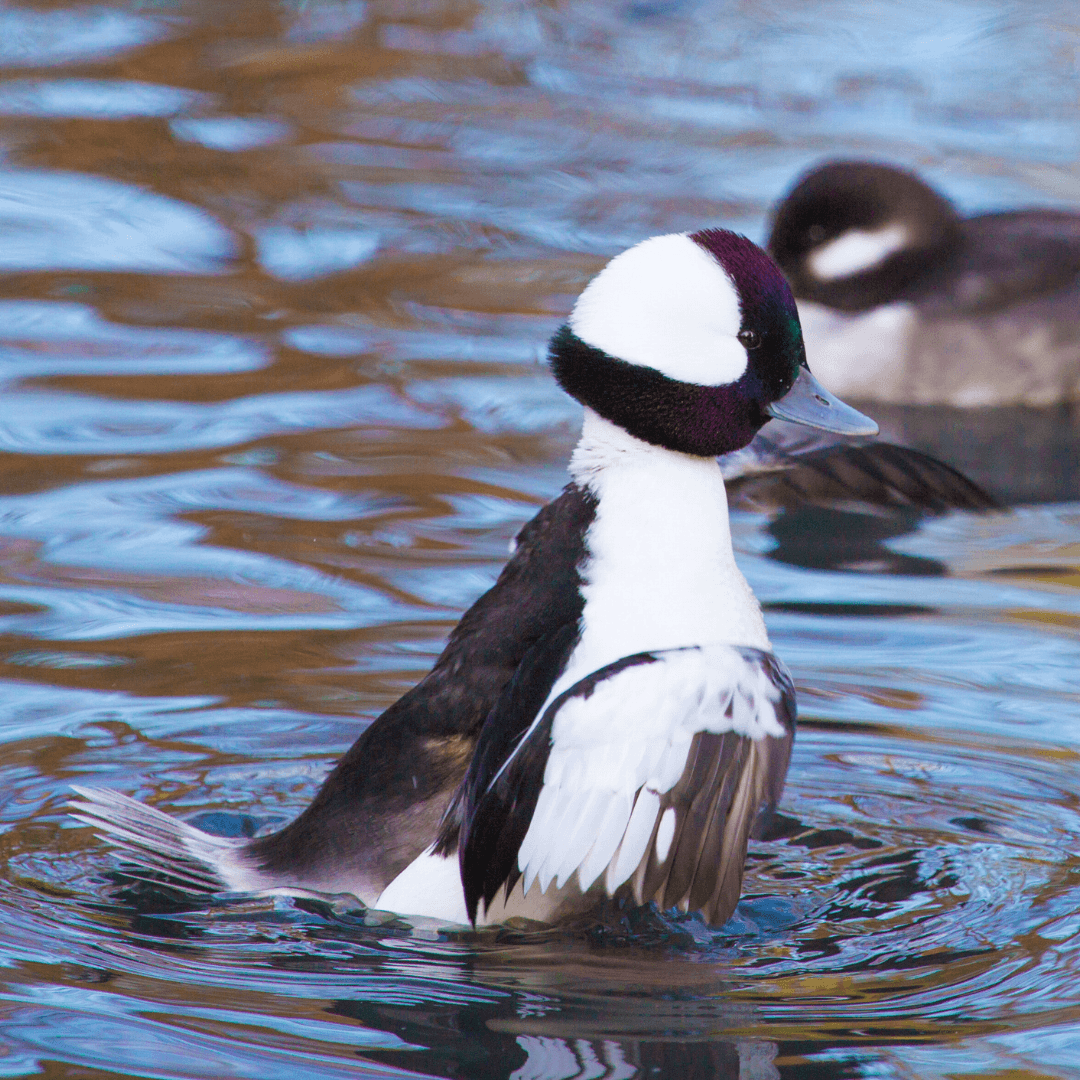
12. Bufflehead (Bucephala albeola)
Buffleheads are small, compact diving ducks. Males have striking black-and-white plumage and large white patches on their heads, while females are grayish with a white cheek patch.
Buffleheads inhabit freshwater lakes, ponds, and coastal bays, often in wooded areas. They dive and forage underwater, feeding on aquatic invertebrates, including insects, crustaceans, and mollusks.
Buffleheads are agile and energetic, known for their fast, erratic flight and ability to take off directly from the water. Their distinctive appearance and behaviour make them a popular species for birdwatching.

13. Northern Shoveler (Spatula clypeata)
Northern Shovelers are medium-sized ducks. Males display green heads, white chests, and chestnut sides, while females are mottled brown.
Northern shovelers have distinctive large, spatula-shaped bills. They inhabit shallow freshwater wetlands, including marshes, ponds, and lakes with abundant aquatic vegetation.
Northern shovelers feed on plankton, aquatic plants, and small invertebrates by filtering food through their bills.
Known for their unique bill shape, adapted for filtering, they often swim in tight circles to stir food. Their specialized feeding habits and striking appearance make them unique among ducks.

14. Green-winged Teal (Anas crecca)
Green-winged Teals are small, compact ducks. Males have chestnut heads, green eye patches, and gray bodies, while females are mottled brown.
They prefer shallow freshwater wetlands, such as marshes, ponds, and flooded fields with dense vegetation.
Green-winged Teals feed on seeds, aquatic plants, insects, and crustaceans by dabbling and skimming the water's surface.
Known for their fast, agile flight and striking green wing patches, Green-winged Teals are among the most miniature dabbling ducks. Their vibrant plumage and energetic behaviour make them a favourite among birdwatchers.

15. Lesser Scaup (Aythya affinis)
Lesser Scaups are medium-sized diving ducks. Males feature blackheads, chests, rumps, gray backs, and white bellies, while females are brown with white face patches.
They inhabit freshwater lakes, rivers, and coastal bays, often in open water. Lesser Scaups feed on aquatic invertebrates, including insects, crustaceans, and mollusks, as well as seeds and aquatic plants by diving and foraging underwater.
Known for their preference for open water, Lesser Scaups often form large flocks during migration. Their distinct plumage and social behaviour make them a critical species in wetland ecosystems.
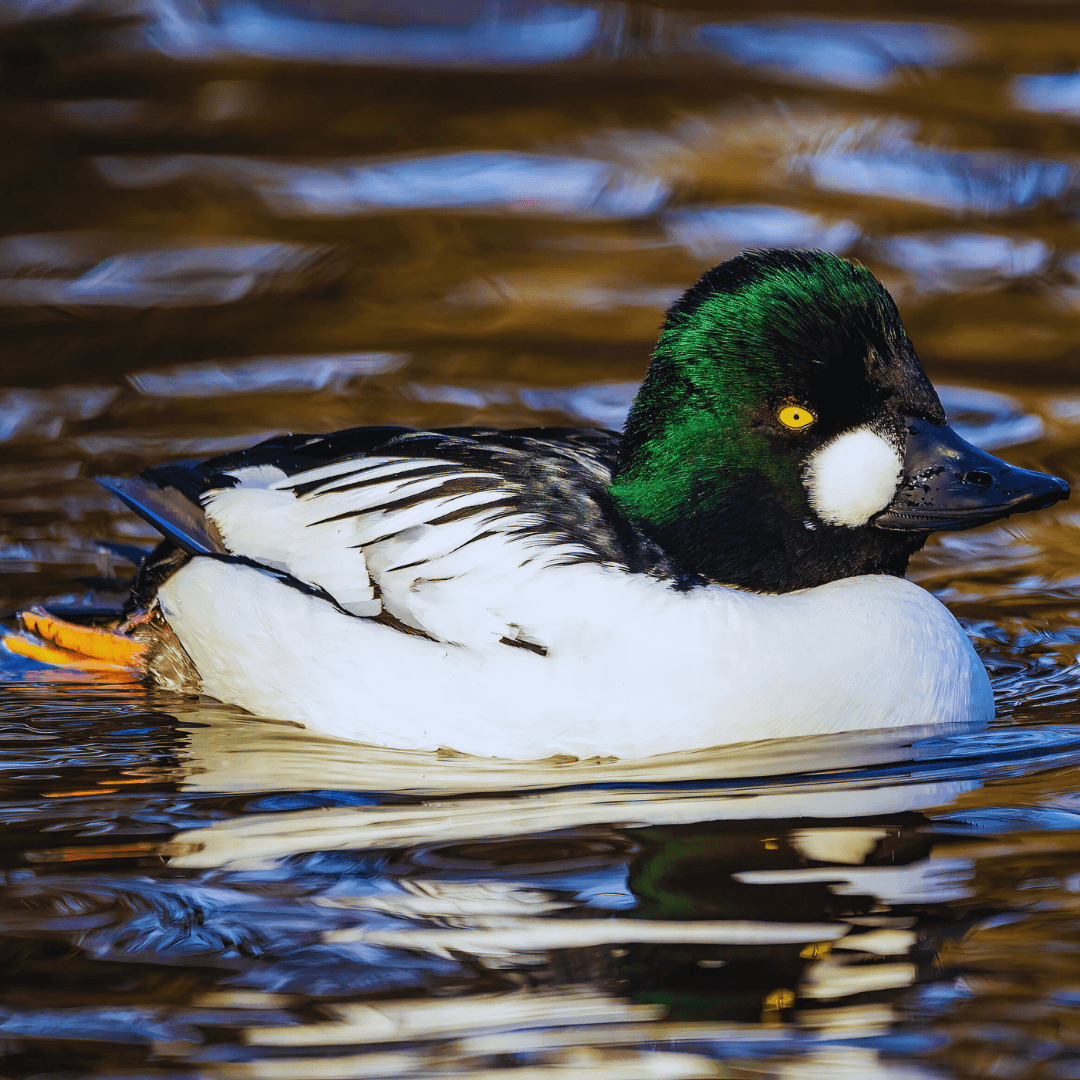
16. Common Goldeneye (Bucephala clangula)
Common Goldeneyes are medium-sized diving ducks. Males have iridescent green heads, white bodies, and distinctive yellow eyes, while females are grayish with brown heads and yellow eyes.
Goldeneyes inhabit freshwater lakes, rivers, and coastal bays, often in wooded areas. By diving and foraging underwater, they feed on aquatic invertebrates, including insects, crustaceans, mollusks, small fish, and plant matter.
Common Goldeneyes are cavity nesters known for their rapid wingbeats and distinctive whistling sound in flight. Their striking appearance and unique flight call make them easily recognizable.
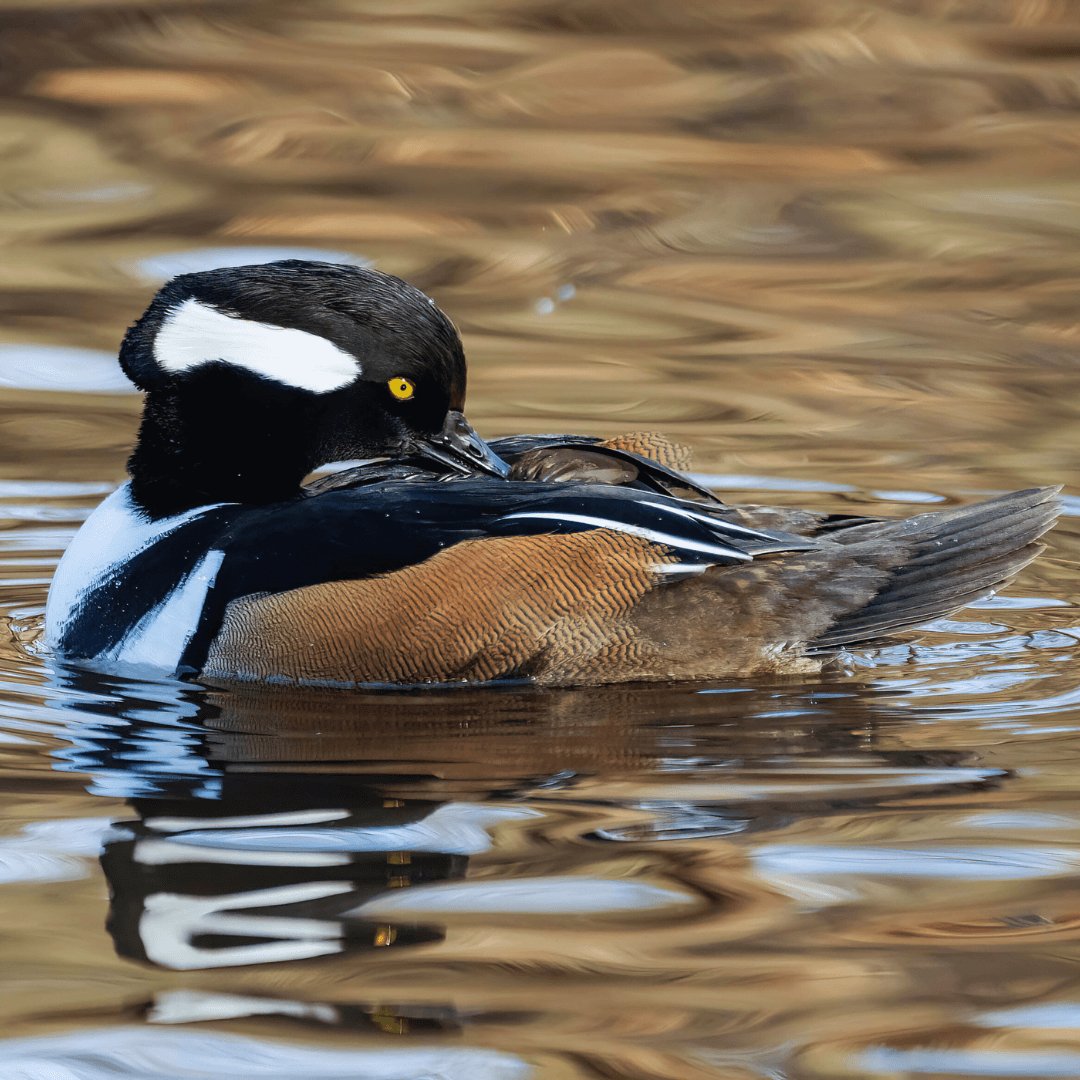
17. Hooded Merganser (Lophodytes cucullatus)
Hooded Mergansers are small, striking diving ducks with males featuring black heads with large, fan-shaped white crests, chestnut sides, and white chests, while females are grayish with reddish-brown crests.
Hooded Mergansers inhabit freshwater lakes, rivers, and wooded swamps, often nesting in tree cavities. They feed on small fish, crustaceans, and aquatic insects by diving and foraging underwater.
Hooded Mergansers are agile divers and swift flyers known for their unique crest displays and striking appearance.
They are ablenest in tree cavities, and their distinctive plumage makes them a unique species among ducks.
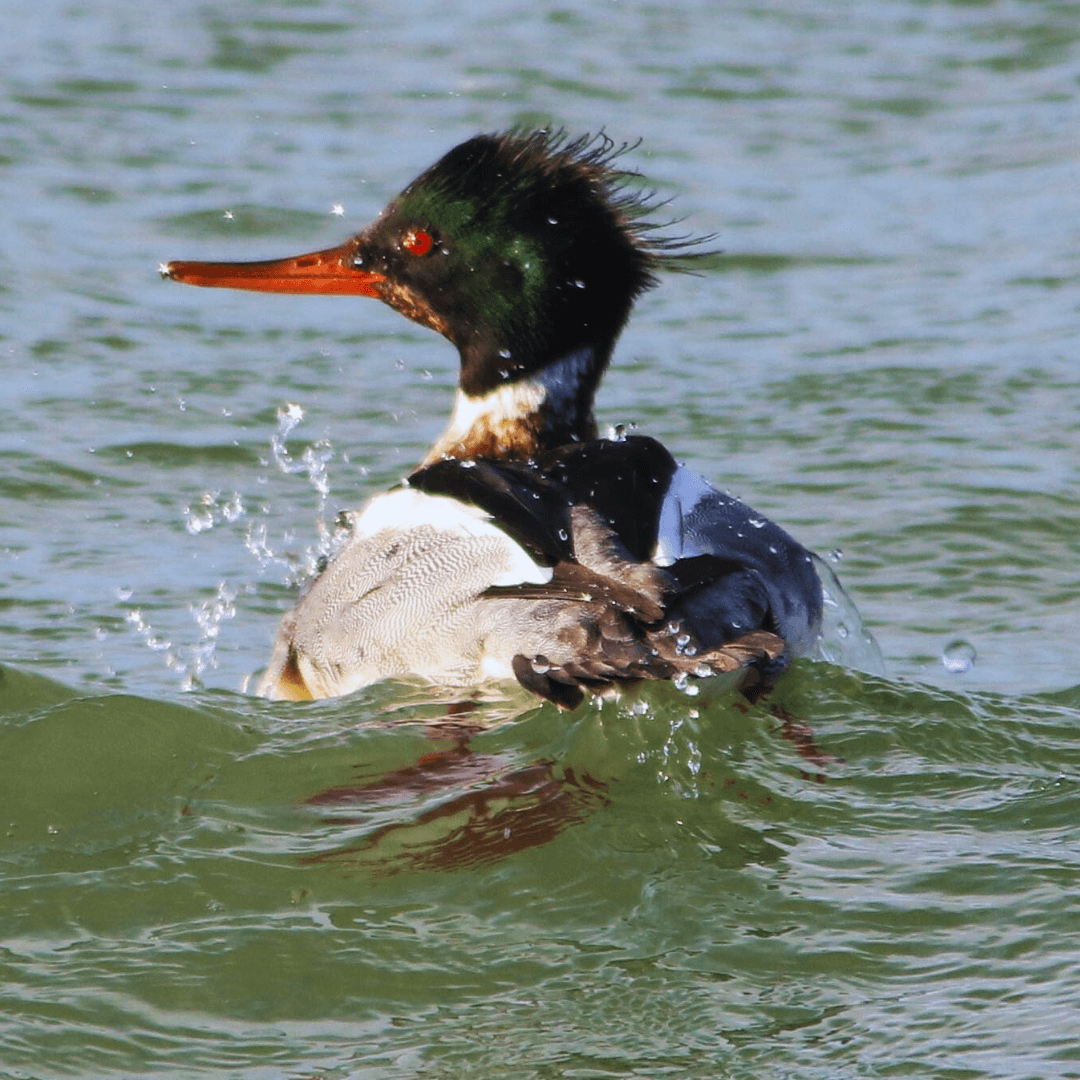
18. Red-breasted Merganser (Mergus serrator)
Red-breasted Mergansers are medium-sized diving ducks, with males having shaggy green heads, red breasts, and white neck rings, while females are grayish with reddish-brown heads and crests.
They inhabit coastal bays, estuaries, and freshwater lakes with abundant fish populations. Red-breasted Mergansers feed on small fish, crustaceans, and aquatic insects by diving and chasing prey underwater.
Known for their distinctive shaggy crests and streamlined bodies, Red-breasted Mergansers are among the fastest-flying ducks. Their mesmerizing look and unique eating habits make them captivating to watch in the wild.
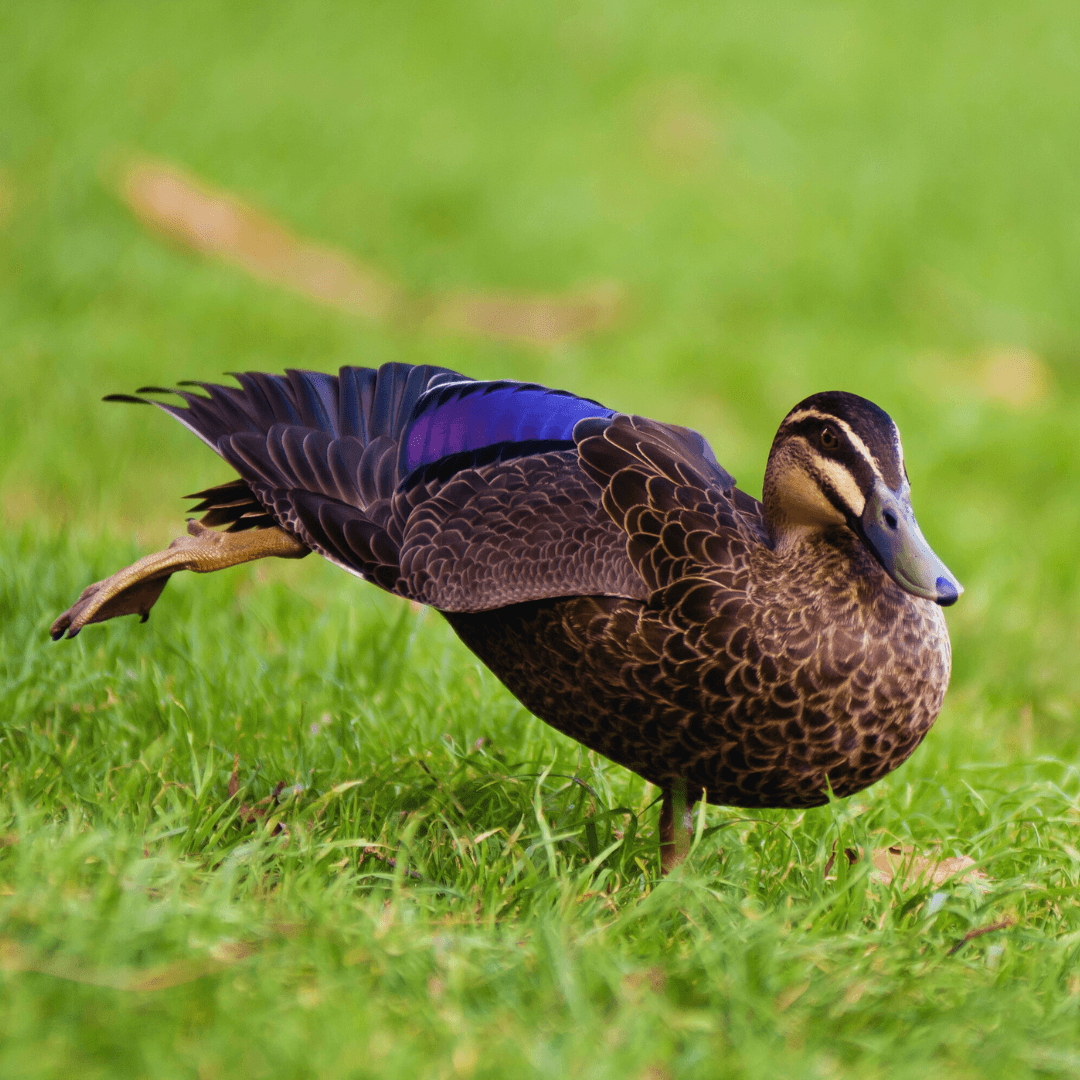
19. Black Duck (Anas rubripes)
Black Ducks are large dabbling ducks, with both males and females having dark brown bodies, pale faces, and contrasting light underwings.
They inhabit freshwater and brackish wetlands, including marshes, ponds, and coastal estuaries, often in dense vegetation.
Black Ducks feed on seeds, aquatic plants, insects, and small fish by dabbling and grazing on land. Known for their adaptability and preference for dense cover, Black Ducks are often found in mixed flocks with Mallards.
Their dark plumage and elusive behaviour make it challenging for them to spot in their preferred habitats.
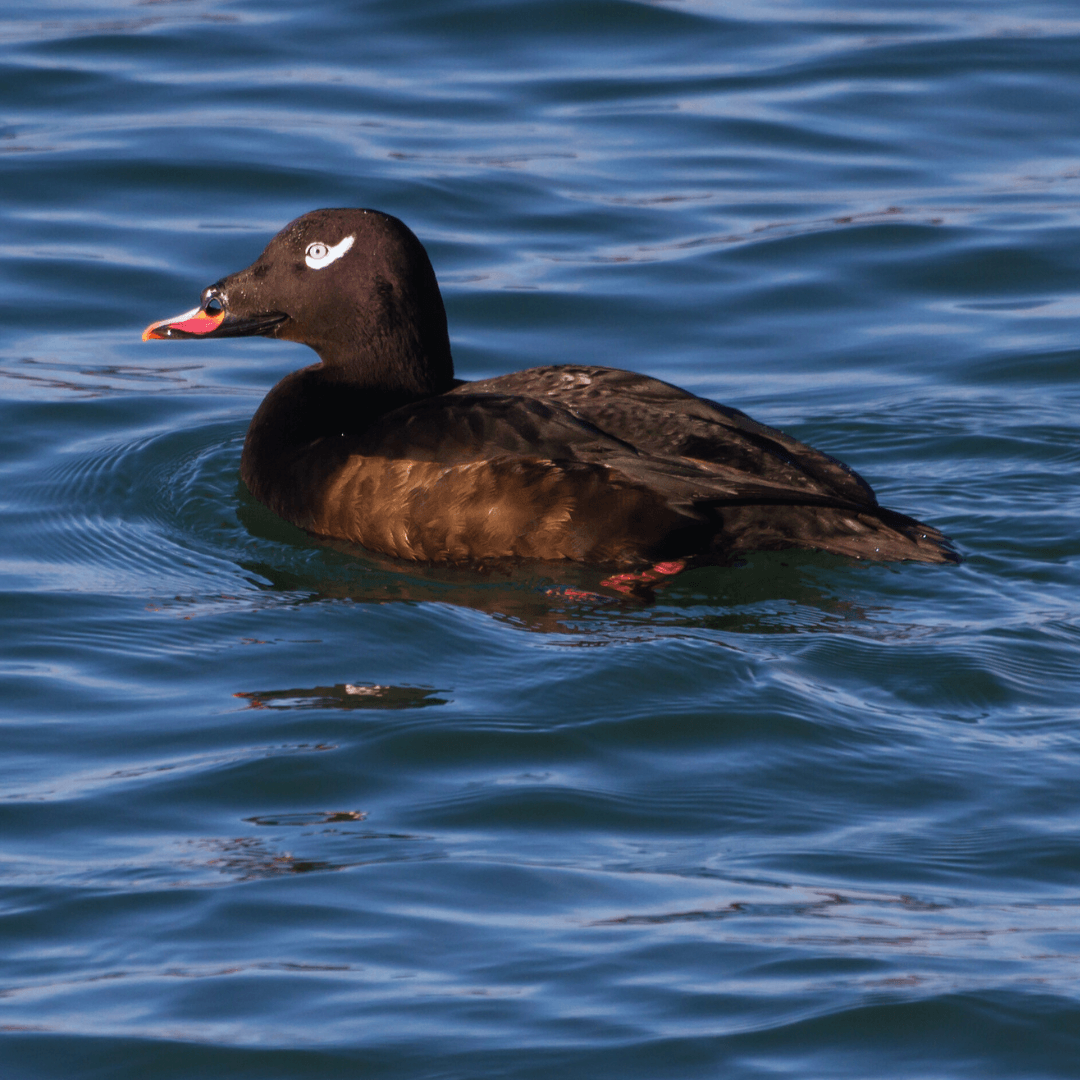
20. White-winged Scoter (Melanitta deglandi)
White-winged Scoters are large sea ducks. Males have black plumage, white eye patches, and distinctive white wing patches, while females are brown with pale facial patches.
They inhabit coastal marine environments, including rocky shores, estuaries, and large freshwater lakes.
White-winged Scoters feed on mollusks, crustaceans, and small fish by diving in deep water. Known for their robust builds and ability to dive to significant depths, they are often seen in large flocks during migration.
Their striking wing patches and powerful diving abilities make them a standout species among sea ducks.
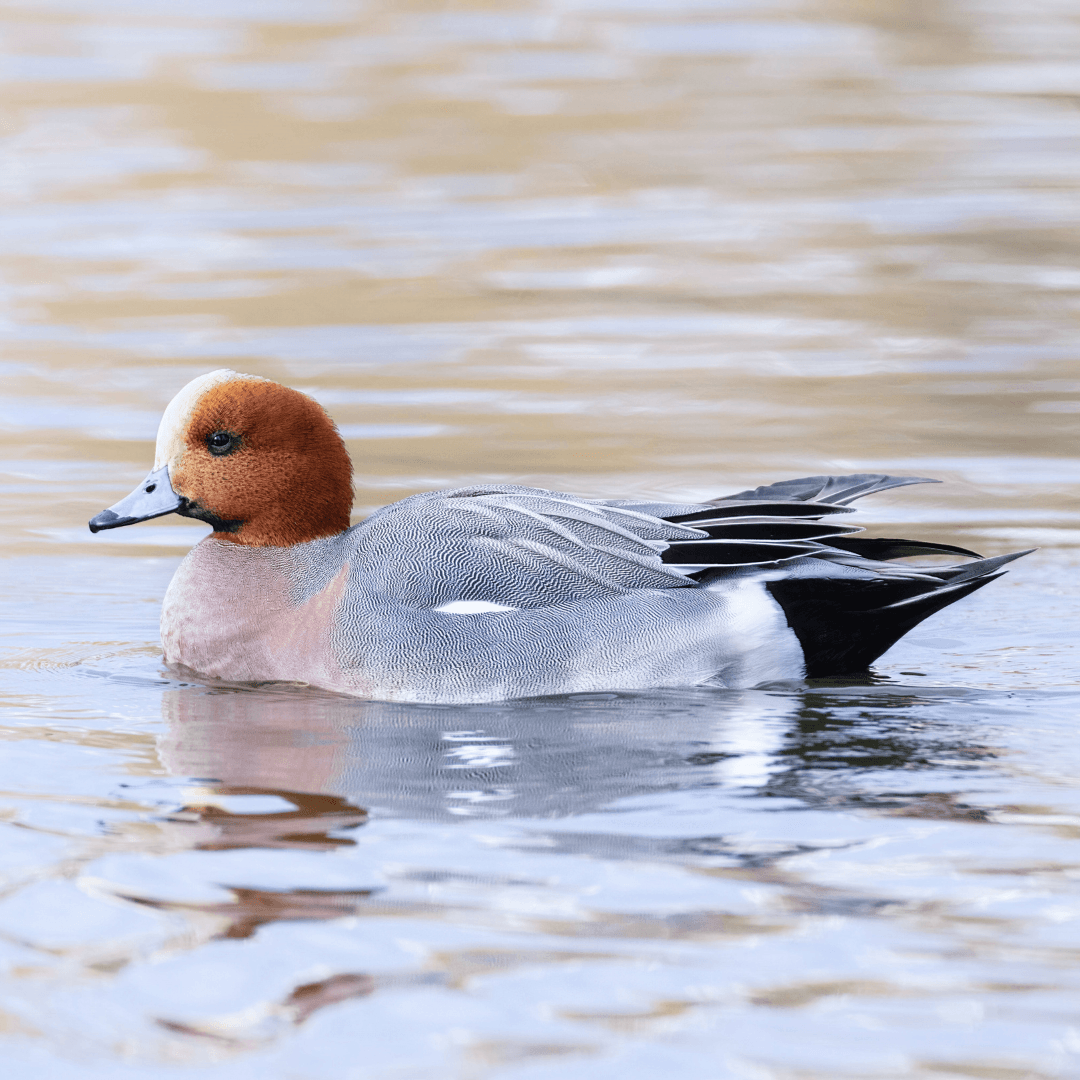
21. Eurasian Wigeon (Mareca penelope)
The Eurasian Wigeon is a stunning medium-sized duck. Males display a chestnut head, cream-coloured forehead, and gray body, while females are mottled brown and more subdued.
They inhabit various wetland habitats, including marshes, lakes, and estuaries, often preferring shallow, vegetated waters.
Eurasian Wigeons feed primarily on aquatic plants, seeds, and grasses but consume insects and small invertebrates.
They forage by dabbling and grazing, often seen alongside other duck species. Known for their distinctive whistling call, Eurasian Wigeons are friendly birds that form large flocks, especially during migration and winter.
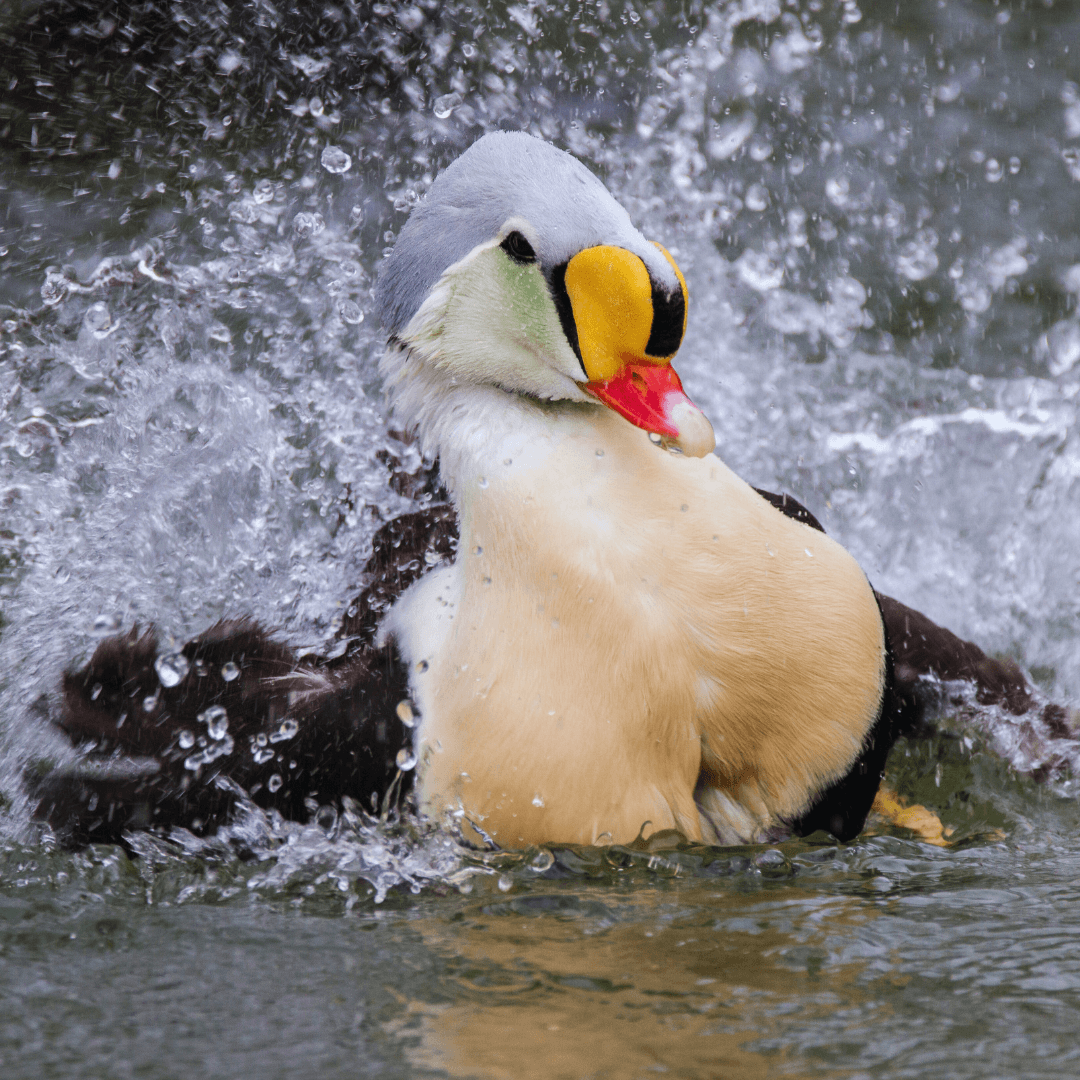
22. King Eider (Somateria spectabilis)
King Eiders are large, striking sea ducks. Males feature vivid orange bills, multicoloured heads, and black-and-white bodies, while females are mottled brown.
They inhabit Arctic coastal waters, breeding in tundra wetlands and wintering in ice-free seas. King Eiders primarily feed on mollusks, crustaceans, and small fish, diving to significant depths to forage.
Known for their vibrant plumage and elaborate courtship displays, they are highly adapted to cold environments.
King Eiders are social birds often seen in large, mixed-species flocks. They are known for their resilience in harsh Arctic conditions.
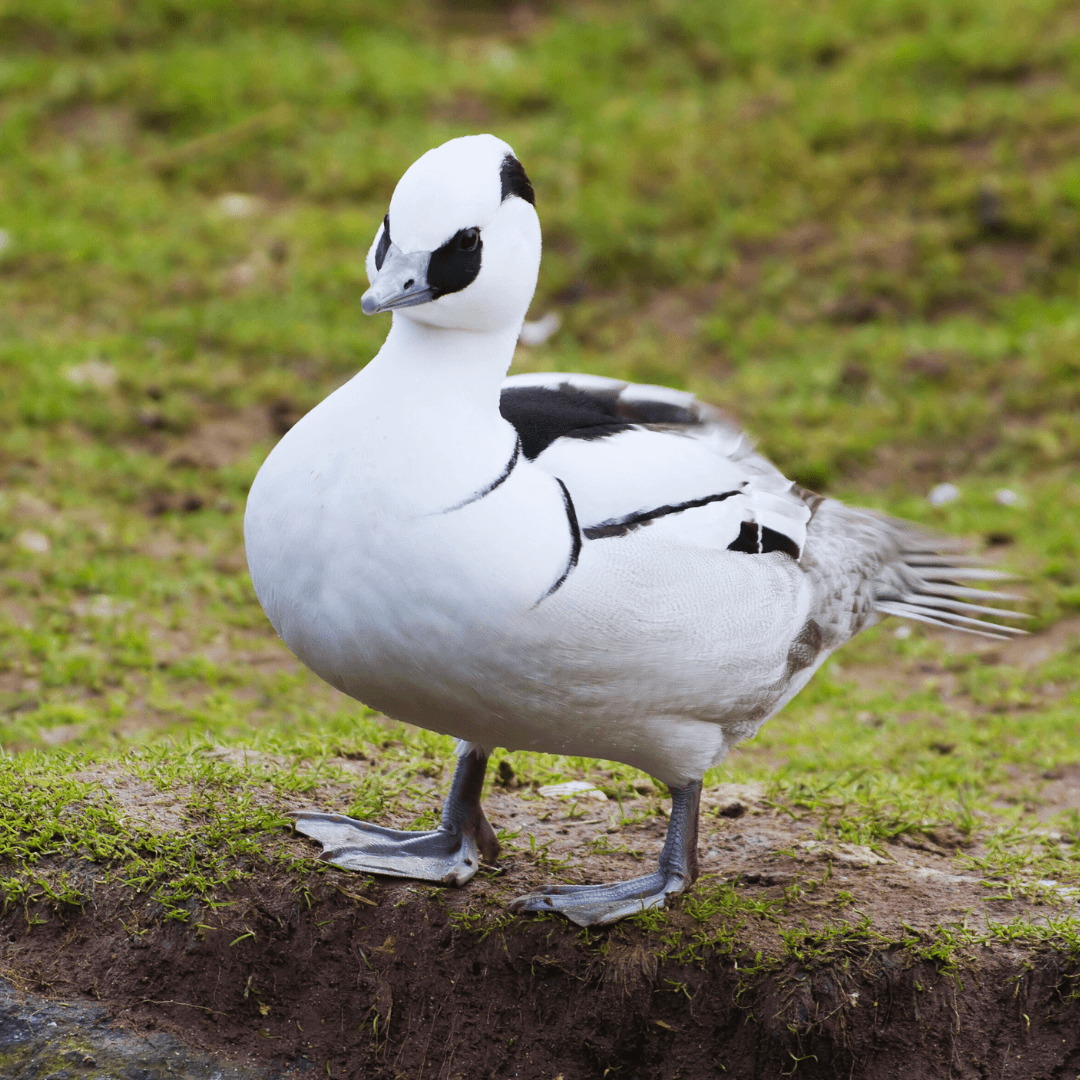
23. Smew (Mergellus albellus)
The Smew is a small, elegant diving duck. Males have striking black-and-white plumage and a distinctive “cracked ice” appearance, while females, known as “redheads,” have gray bodies and chestnut heads.
They inhabit freshwater lakes, rivers, and sheltered coastal waters, especially in forested northern Europe and Asia.
Smews feed on small fish, aquatic insects, and crustaceans by diving and foraging underwater. Known for their fast, agile flight and unique appearance, Smews are often seen in small flocks during migration and winter.
Their preference for cold, clear waters and striking looks make them a favourite among birdwatchers.

24. Spectacled Eider (Somateria fischeri)
Spectacled Eiders are large sea ducks. Males have distinctive black-and-white plumage and prominent white “spectacles” around their eyes, while females are mottled brown with less pronounced eye markings.
They inhabit coastal tundra wetlands during the breeding season and migrate to the Bering Sea's ice-free waters for winter.
Spectacled Eiders feed on mollusks, crustaceans, and marine worms by diving and foraging in shallow waters.
Known for their striking appearance and specialized Arctic habitat, they are among the most visually unique and environmentally adapted duck species. Their large, dense flocks on wintering grounds are a remarkable sight.

25. Marbled Duck (Marmaronetta angustirostris)
The Marbled Duck is a medium-sized, mottled brown duck with a long neck and a distinctive marbled pattern on its plumage.
They inhabit freshwater marshes, lakes, and slow-moving rivers in Mediterranean and West Asian regions, often in areas with dense emergent vegetation.
Marbled Ducks feed on seeds, aquatic plants, and invertebrates, foraging by dabbling and upending in shallow water.
Known for their cryptic plumage that provides excellent camouflage in their preferred habitats, Marbled Ducks are shy and elusive.
Their preference for specific wetland habitats makes them vulnerable to habitat loss, leading to conservation efforts focused on protecting and restoring their environments.
Conclusion
In conclusion, exploring the diverse world of ducks reveals these waterfowl's incredible variety and adaptability.
Each species, from the vividly coloured Wood Duck to the strikingly patterned Smew, offers a unique glimpse into the intricate web of life in aquatic habitats.
Understanding the different duck types enriches our appreciation for biodiversity and highlights the importance of conserving their habitats.
As ducks face habitat loss and climate change challenges, it is crucial to support conservation efforts to ensure these fascinating birds continue to thrive.
Accept the variety and beauty of ducks and allow their existence to serve as a constant reminder of the fragile natural equilibrium that needs to be preserved.
I trust you enjoyed this article on A Comprehensive List Of Duck Types. Please stay tuned for more blog posts soon. Take care!
JeannetteZ
Your Opinion Is Important To Me
Do you have thoughts, ideas, or questions? I would love to hear from you. Please leave me your questions, experiences, and remarks about this article, A Comprehensive List Of Duck Types, in the comments section below. You can also email me at Jeannette@Close-To-Nature.org.
Disclosure
This post may contain affiliate links. As an Amazon Associate and other affiliate programs, I earn from qualifying purchases at no extra cost to you. Please read my full affiliate disclosure.
You might also enjoy these blog posts:
Fun Facts About The Northern Cardinal
Interesting Facts About Mourning Doves
Symptoms Of Omega-3 Deficiency

